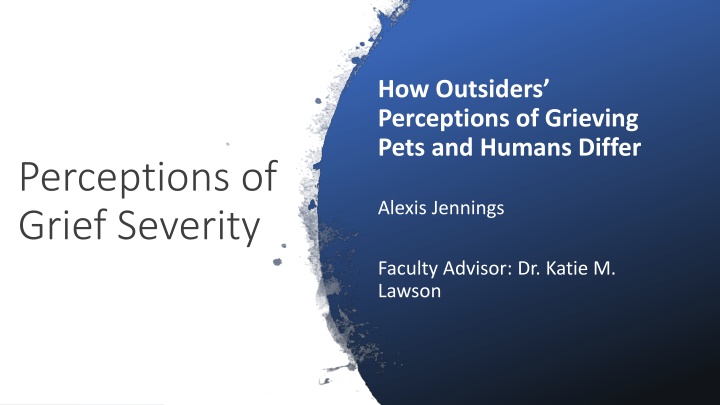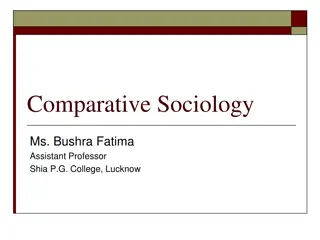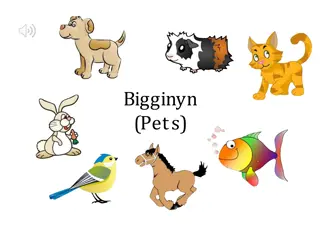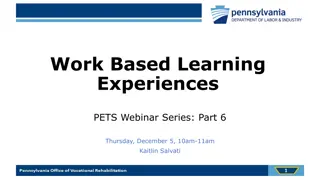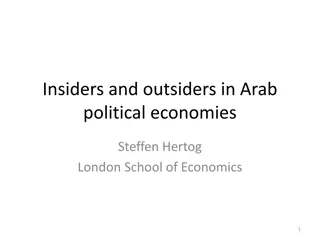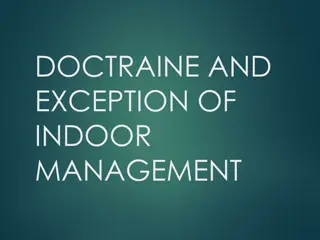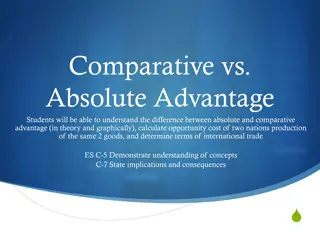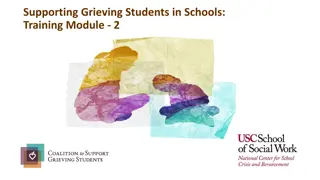Outsiders' Perceptions of Grieving Pets vs. Humans: A Comparative Study
It explores how outsiders perceive grief severity in pet owners versus those grieving humans, shedding light on societal attitudes towards pet bereavement and its impact on individuals. The study aims to reveal potential differences in empathy and support for individuals mourning the loss of a pet compared to a human.
Download Presentation

Please find below an Image/Link to download the presentation.
The content on the website is provided AS IS for your information and personal use only. It may not be sold, licensed, or shared on other websites without obtaining consent from the author.If you encounter any issues during the download, it is possible that the publisher has removed the file from their server.
You are allowed to download the files provided on this website for personal or commercial use, subject to the condition that they are used lawfully. All files are the property of their respective owners.
The content on the website is provided AS IS for your information and personal use only. It may not be sold, licensed, or shared on other websites without obtaining consent from the author.
E N D
Presentation Transcript
How Outsiders Perceptions of Grieving Pets and Humans Differ Perceptions of Grief Severity Alexis Jennings Faculty Advisor: Dr. Katie M. Lawson
As early as 1988, households on average had more pets than children total (Gage & Holcomb, 1991). Pet ownership continues to be on the rise with Millennial households being majority of pet owners (American Veterinary Medical Association, 2017). As pet ownership increases, more are potentially exposed to the experience of pet death. Pet Culture
Experiencing Death Bereavement and grieving is one of the most stressful life events humans experience (Prigerson et al., 1995). Bereavement experiences are associated with a higher risk of depressive symptoms, emotional disturbances, immune system impairments, decreased physical health, and suicide (Prigerson et al., 1995). Humans tend to experience grief rumination, which may result in maladaptive habits, unless challenged with support, care, and treatment (Eisma et al., 2013). Grief and depressive rumination may lead to psychopathology such as depressive disorders (Eisma et al., 2013).
A Pets Death Past research has shown that grieving a pet has little support from major institutions like employment (Packman et al., 2012; Wrobel & Dye, 2003). Despite pets being often considered part of the family, pet death received little societal and research focus on the experience (Eckerd et al., 2016). Pets may have confirmed deaths but are at a higher risk for fleeing or getting lost, leading to the stressful experience of ambiguous grief, a type of grief caused by an uncertain outcome (Green et al., 2018). Furthermore, ambiguous grief and pet grief are both considered forms of disenfranchised grief, a type of grief considered illegitimate by the larger culture (Eckerd et al., 2016; Packman et al., 2012). Past research has shown that the severity of grief over a pet does not differ from that of grieving another human, such as a close friend or spouse (Gerwolls & Labott, 1994; Kimura et al., 2014; Eckerd et al., 2016).
Until now, comparing experiences of pet bereavement and human bereavement has been almost strictly correlational Experimental design Assess whether participants perceptions of grief severity differed between conditions of mourning a pet versus human Current Study
1. Participants will allow less time off for the employee in the pet condition, relative to the human condition. 2. Participants will rate the perceptions of an individual s experiences of grief as less severe if they recently lost a pet, relative to individuals who lost a close friend. 3. Participants will perceive the employee s stress and psychological distress to be less severe for the employee in the pet condition, relative to individuals who lost a close friend. 4. Females will allow more time off for the employee and perceive the grief, stress, and psychological distress as more severe, compared to men. Hypotheses 5. For those who experienced the loss of a pet, there will be a positive correlation between grief rating and perceptions of the employee s grief. More specifically, higher levels of grief will be associated with allowing more time off, higher perceptions of grief, stress, and psychological distress.
Methods Participants 220 total recruited from Reddit, Facebook, university communications center 46 responses pruned Majority white (96.3%) white and female (88.15%) Mean age of 39.15, Median age of 41.5 Procedure Read vignette imagining self as manager with employee requesting time off over a death (pet or human) Answer Time Off Request, Psychological Distress Scale, Perceived Stress Scale, Core Bereavement Index, Demographics, then Pet Bereavement Questionnaire if applicable
Scales Time Off Request (developed for the study), between 0-14 days allowed Psychological Distress Scale (Kessler et al., 2003), Cronbach s alpha = .83 Perceived Stress Scale (Cohen et al., 1983), Cronbach s alpha = .62 Core Bereavement Index (Burnett e al., 1997), Cronbach s alpha = .93 Pet Bereavement Questionnaire (Hunt & Padilla, 2006), edited by Matte et al., 2003, Cronbach s alpha = .92
Results (H1) Participants will allow less time off for the employee in the pet condition, relative to the human condition. t(190) = -3.7 p < .0001, Cohen s d = -.53. (H2) Participants will rate the perceptions of an individual s experiences of grief as less severe if they recently lost a pet, relative to individuals who lost a close friend. t(168) = -1.45, p = .15, Cohen s d = -.22.
Results (H3) Participants will perceive the employee s stress and psychological distress to be less severe for the employee in the pet condition, relative to individuals who lost a close friend. Perceived Stress: t(178) = -2.37, p = .019, Cohen s d = -.35. Psychological Distress: t(189) = -5.68, p < .0001, Cohen s d = -.82.
Results (H4) Females will allow more time off for the employee and perceive the grief, stress, and psychological distress as more severe, compared to men. Time Off: t(166) = .06, p = .949, Cohen s d = .02. Perceived Grief: t(165) = -2.30, p = .023, Cohen s d = -.57. Perceived Stress: t(166) = 1.36, p = .176, Cohen s d = .33. Psychological Distress: t(166) = .902, p = .368, Cohen s d = .22.
Results (H5) For those who experienced the loss of a pet, there will be a positive correlation between grief rating and perceptions of the employee s grief. More specifically, higher levels of grief will be associated with allowing more time off, higher perceptions of grief, stress, and psychological distress. r = .381, p < .0001
Discussion Participants allowed less time off for an employee grieving a dog rather than one grieving a friend. Participants viewed the perceived grief to be equal for both the dog and friend conditions. Participants viewed the employee s stress to be worse in response to the death of a friend than for the death of a dog. Psychological distress was perceived to be more severe for grieving a friend than grieving a dog.
Discussion Females perceived the grief of the employee to be significantly worse compared to male s perceptions, but did not differ on perceptions of perceived stress, psychological stress, nor did they allow more/less time off. The higher the respondent s level of grief over a pet had been in the past, the higher they reported their perception of the employee s grief, regardless of condition.
References For full list of references, see attached document labelled References
